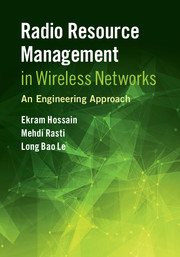Book contents
- Frontmatter
- Contents
- Preface
- Part I Basics of Wireless Networks
- Part II Techniques for Modeling and Analysis of Radio Resource Allocation Methods in Wireless Networks
- Part III Physical Layer Resource Allocation in Wireless Networks
- 5 General System Model and Preliminary Concepts
- 6 Power Control in Cellular Wireless Networks
- 7 Distributed Joint Power and Admission Control
- 8 Joint Power and Admission Control in Cognitive Radio Networks
- 9 Cell Association in Cellular Networks
- Part IV Link Layer Resource Allocation in Wireless Networks
- Part V Cross-Layer Modeling for Resource Allocation in Wireless Networks
- Index
- References
8 - Joint Power and Admission Control in Cognitive Radio Networks
from Part III - Physical Layer Resource Allocation in Wireless Networks
Published online by Cambridge University Press: 11 May 2017
- Frontmatter
- Contents
- Preface
- Part I Basics of Wireless Networks
- Part II Techniques for Modeling and Analysis of Radio Resource Allocation Methods in Wireless Networks
- Part III Physical Layer Resource Allocation in Wireless Networks
- 5 General System Model and Preliminary Concepts
- 6 Power Control in Cellular Wireless Networks
- 7 Distributed Joint Power and Admission Control
- 8 Joint Power and Admission Control in Cognitive Radio Networks
- 9 Cell Association in Cellular Networks
- Part IV Link Layer Resource Allocation in Wireless Networks
- Part V Cross-Layer Modeling for Resource Allocation in Wireless Networks
- Index
- References
Summary
Introduction
Due to increasing demand for wireless access services, efficient utilization of the limited frequency spectrum has become crucial. Exclusive licensing of spectrum bands to specific users or services is very inefficient from the viewpoint of spectrum utilization, and it lacks the agility needed to support new applications. Cognitive radio networks (CRNs) have thus emerged as an adaptive cohabitation paradigm for wireless communication. The primary radio networks (PRNs) can dynamically share the spectrum with the secondary users (SUs) so that the SUs achieve their minimum acceptable quality-of- service (QoS), and at the same time, all the primary users (PUs) are protected in the sense that the SUs do not violate the QoS requirements of the PUs.
The key concept in cognitive radio networks is opportunistic or dynamic spectrum access, which allows SUs to opportunistically access the band licensed to the PUs. There are two approaches for opportunistic spectrum access: spectrum overlay and spectrum underlay. In the overlay spectrum access strategy, the channels that are unused by the PUs are detected by the CRN through spectrum-sensing mechanisms and are assigned to the SUs. With overlay spectrum access, a channel-sharing method such as orthogonal frequency division multiple access (OFDMA) or time division multiple access (TDMA) is employed where spectrum holes (e.g., unused frequency or time slots) are detected and accessed in an opportunistic manner by SUs. In the underlay scenario, the available frequency spectrum is shared by all of the PUs and SUs, and since the admission of any of the SUs causes interference to all of the PUs’ receiving points, the interference caused by the SUs must be controlled through power control strategies in a way that all PUs are protected (i.e., all PUs achieve their target signal-to-interference-plus-noise ratio [SINR]). With underlay spectrum users employ channel sharing methods such as code-division multiple access (CDMA) or OFDMA in a way that the interference imposed by the SUs remains below a specified threshold and the QoS requirements of all of the PUs are supported. Therefore, with underlay spectrum access, which we focus on in this chapter, the overall spectrum can be utilized more effectively at the expense of higher complexity in controlling the QoS of SUs and the aggregate interference caused to the primary receivers.
- Type
- Chapter
- Information
- Radio Resource Management in Wireless NetworksAn Engineering Approach, pp. 245 - 275Publisher: Cambridge University PressPrint publication year: 2017



